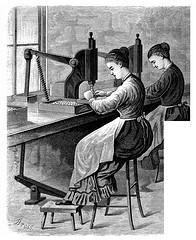Question by mich_alwayscool: how is paper manufactured?
Ideal answer:
Answer by inatuk
Manufacturing
International Paper Firm: Kraft paper mill, situated in Georgetown, South Carolina
Enlarge
International Paper Business: Kraft paper mill, located in Georgetown, South Carolina
Regardless of whether done by hand or with a paper machine, the paper making procedure has three basic steps:
[edit]
Preparation of the fibers
The material to be employed for creating paper is very first converted into pulp, a concentrated mixture of fibers suspended in liquid. The source of fiber is usually natural (softwood or hardwood trees or other plants) or recycled, such as old corrugated boxes, newsprint, or mixed paper.
When best sheets materials are utilised to make paper, it is generally necessary to break down the lignin inside of the plant’s cell walls. This is carried out via a chemical approach, such as the Kraft approach. These processes are not necessary when breaking down recycled fibers, as the lignin has already been removed from the source material. If the lignin is retained in the pulp, the paper will yellow when exposed to air and light.
Pulp that has been broken down mechanically is usually recognized as “groundwood pulp.” The mechanical approach to break down wood chips into pulp requires no chemical substances. Because the lignin is not removed from mechanical pulp, yields are relatively high, around 90-98%. Nevertheless, due to the aging issues indicated above, mechanical pulp is most frequently used for newspapers and other non-permanent goods.
Pulp that is broken down chemically is identified as “chemical pulp.” The principal purpose of a chemical pulping approach is to break down the chemical structure of lignin and render it soluble in a liquid (most often water) so it may be washed from the remaining fibers. Removing the lignin from wood chips also serves to break them apart into the fibers that compose pulp.
Recycled fibres do not want to be pulped in the conventional sense. These fibres have currently been treated when, so as an alternative they need to have a much more gentle method to break the fibers apart while preserving their integrity.
When the fibers have been extracted, they may also be bleached, dyed, or have added components added to alter the look of the final solution. For instance, Kaolin (or calcium carbonate) is added to make the glossy papers usually employed for magazines. The Kappa quantity indicates how considerably bleach is necessary to get a offered whiteness.
[edit]
Sheet formation
The pulp mixture is additional diluted with water resulting in a quite thin slurry. This dilute slurry is drained by means of a fine-mesh moving screen to type a fibrous net. A watermark could be impressed into the paper at this stage of the method. This mark is employed on paper currency and other factors. This moving net is pressed and dried into a continuous sheet of paper.
In the mould procedure, a quantity of pulp is placed into a type, with a wire-mesh base, so that the fibers form a sheet on the mesh and excess water can drain away. Pressure may be applied to aid eliminate extra water. The paper could then be removed from the mould, wet or dry, and go on to further processing.
Most mass-produced paper is made employing the continuous Fourdrinier method to kind a reel or web of fibers in a thin sheet. When dried, this continuous web may possibly be reduce into rectangular sheets by slicing the internet vertically and horizontally to the desired size. Standard sheet sizes are prescribed by governing bodies such as the International Organization for Standardization (ISO).
[edit]
Drying
After the paper net is developed, the water have to be removed from it in order to produce a usable solution. This is achieved by way of pressing and drying. The approaches of doing so differ amongst the diverse processes utilized to make paper, but the concepts stay the same.
Pressing the sheet removes the water by force. As soon as the water is forced from the sheet, yet another absorbant material must be utilized to gather this water. On a paper machine this is named a felt (not to be confused with the classic felt). When producing paper by hand, a blotter sheet is utilised.
Drying includes making use of air and or heat to remove water from the paper sheet. In the earliest days of papermaking this was carried out by hanging the paper sheets like laundry. In more contemporary instances, a variety of types of heated drying mechanisms are utilized. On the paper machine, the most typical is the steam-heated can dryer. These dryer cans heat to temperatures above 200ºF and are employed in lengthy sequences of a lot more than 40 cans. The heat produced by these can very easily dry the paper to less than six% moisture.
Give your answer to this question under!
